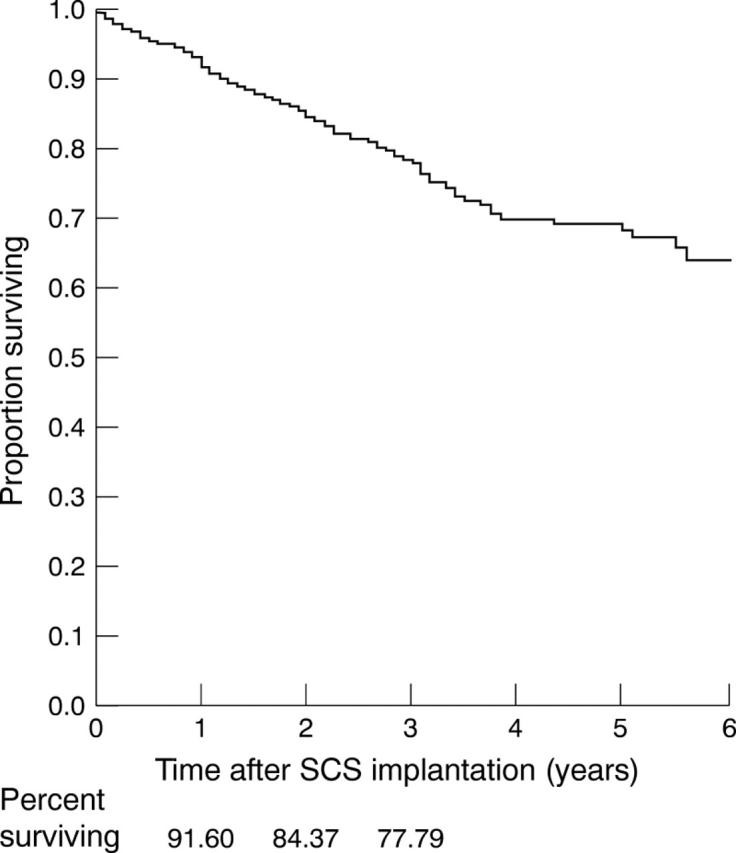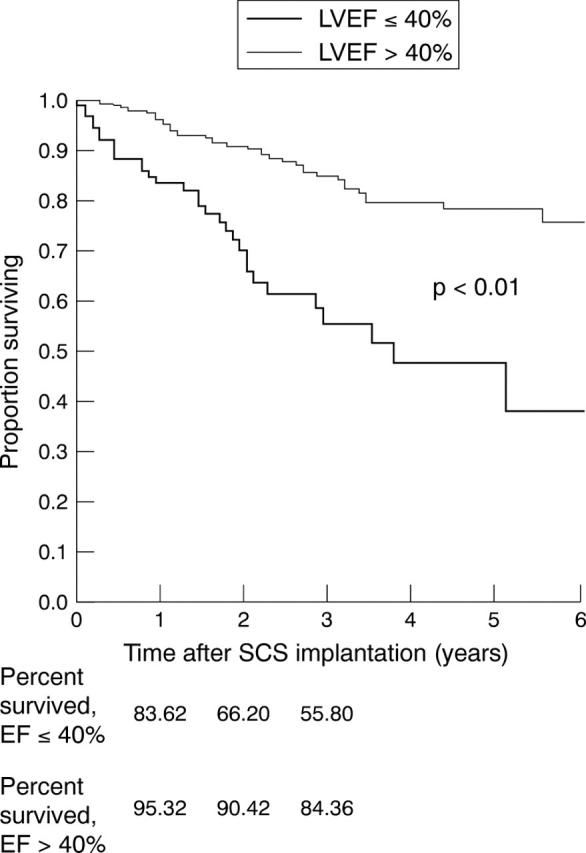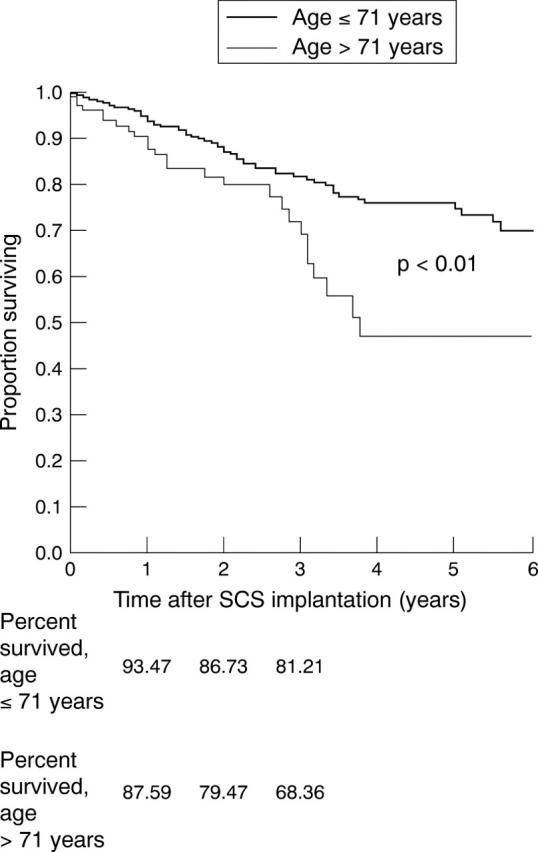Abstract
OBJECTIVE—To determine morbidity and mortality characteristics in patients treated with electrical neuromodulation for refractory angina pectoris. DESIGN—A retrospective multicentre study of patients treated with spinal cord stimulation between 1987 and 1997; 21 centres were contacted and 14 responded. SETTING—Specialist centres worldwide. PATIENTS—Questionnaires were returned on 517 patients, of whom 71% were male. One was lost to follow up. Mean (SD) age was 63.9 (10.1) years. Duration of angina pectoris was 8.1 (6.3) years. RESULTS—Before spinal cord stimulation, 66% of the patients had experienced myocardial infarction, 68% had three vessel disease, and in 24% the left ventricular ejection fraction (LVEF) was ⩽ 40%. Percutaneous transluminal coronary angioplasty and bypass surgery were performed in 17% and 58% of the subjects, respectively. During a median follow up of 23 months (range 0 to 128), 103 patients died (52 from a cardiac cause, 25 from a non-cardiac cause, and 26 from an unknown cause). Annual all cause mortality was 7-8%; annual cardiovascular fatality was 3.5-5%. Mortality was univariately related to sex, number of diseased vessels, number of revascularisation procedures, previous myocardial infarction, LVEF, insulin dependent diabetes, β blocking agents, and angiotensin converting enzyme inhibitors. Multiple variate analysis showed that LVEF, sex, β blockers, and age ⩾ 71 years were independent predictors of mortality. During spinal cord stimulation, New York Heart Association functional class improved from 3.5 to 2.1 (p < 0.01); 25 of the deceased patients (24%) and 32 survivors (8%) experienced myocardial infarction; hospital admissions were significantly (p < 0.001) more common in the deceased group (66% v 37%). CONCLUSIONS—The clinical outcome of patients with intractable angina is not adversely affected by the chronic use of neurostimulation. Keywords: angina pectoris; spinal cord stimulation; pain
Full Text
The Full Text of this article is available as a PDF (156.4 KB).
Figure 1 .

Kaplan-Meier survival curve for entire group of patients. SCS, spinal cord stimulation.
Figure 2 .

Kaplan-Meier survival curve for patients with a left ventricular ejection fraction of ⩽ 40% and > 40% (see text for details). SCS, spinal cord stimulation.
Figure 3 .

Kaplan-Meier survival curves for patients with age ⩽ 71 years and > 71 years (see text for details). SCS, spinal cord stimulation.
Selected References
These references are in PubMed. This may not be the complete list of references from this article.
- Andersen C., Hole P., Oxhøj H. Does pain relief with spinal cord stimulation for angina conceal myocardial infarction? Br Heart J. 1994 May;71(5):419–421. doi: 10.1136/hrt.71.5.419. [DOI] [PMC free article] [PubMed] [Google Scholar]
- Cameron A. A., Davis K. B., Rogers W. J. Recurrence of angina after coronary artery bypass surgery: predictors and prognosis (CASS Registry). Coronary Artery Surgery Study. J Am Coll Cardiol. 1995 Oct;26(4):895–899. doi: 10.1016/0735-1097(95)00280-4. [DOI] [PubMed] [Google Scholar]
- Chauhan A., Mullins P. A., Thuraisingham S. I., Taylor G., Petch M. C., Schofield P. M. Effect of transcutaneous electrical nerve stimulation on coronary blood flow. Circulation. 1994 Feb;89(2):694–702. doi: 10.1161/01.cir.89.2.694. [DOI] [PubMed] [Google Scholar]
- Davis K. B., Chaitman B., Ryan T., Bittner V., Kennedy J. W. Comparison of 15-year survival for men and women after initial medical or surgical treatment for coronary artery disease: a CASS registry study. Coronary Artery Surgery Study. J Am Coll Cardiol. 1995 Apr;25(5):1000–1009. doi: 10.1016/0735-1097(94)00518-u. [DOI] [PubMed] [Google Scholar]
- De Landsheere C., Mannheimer C., Habets A., Guillaume M., Bourgeois I., Augustinsson L. E., Eliasson T., Lamotte D., Kulbertus H., Rigo P. Effect of spinal cord stimulation on regional myocardial perfusion assessed by positron emission tomography. Am J Cardiol. 1992 May 1;69(14):1143–1149. doi: 10.1016/0002-9149(92)90926-p. [DOI] [PubMed] [Google Scholar]
- González-Darder J. M., Canela P., González-Martinez V. High cervical spinal cord stimulation for unstable angina pectoris. Stereotact Funct Neurosurg. 1991;56(1):20–27. doi: 10.1159/000099389. [DOI] [PubMed] [Google Scholar]
- Guidelines and indications for coronary artery bypass graft surgery. A report of the American College of Cardiology/American Heart Association Task Force on Assessment of Diagnostic and Therapeutic Cardiovascular Procedures (Subcommittee on Coronary Artery Bypass Graft Surgery). J Am Coll Cardiol. 1991 Mar 1;17(3):543–589. [PubMed] [Google Scholar]
- Hautvast R. W., Blanksma P. K., DeJongste M. J., Pruim J., van der Wall E. E., Vaalburg W., Lie K. I. Effect of spinal cord stimulation on myocardial blood flow assessed by positron emission tomography in patients with refractory angina pectoris. Am J Cardiol. 1996 Mar 1;77(7):462–467. doi: 10.1016/s0002-9149(97)89338-1. [DOI] [PubMed] [Google Scholar]
- Holmes D. R., Jr, Davis K., Gersh B. J., Mock M. B., Pettinger M. B. Risk factor profiles of patients with sudden cardiac death and death from other cardiac causes: a report from the Coronary Artery Surgery Study (CASS). J Am Coll Cardiol. 1989 Mar 1;13(3):524–530. doi: 10.1016/0735-1097(89)90587-1. [DOI] [PubMed] [Google Scholar]
- Jessurun G. A., Ten Vaarwerk I. A., DeJongste M. J., Tio R. A., Staal M. J. Sequelae of spinal cord stimulation for refractory angina pectoris. Reliability and safety profile of long-term clinical application. Coron Artery Dis. 1997 Jan;8(1):33–38. doi: 10.1097/00019501-199701000-00005. [DOI] [PubMed] [Google Scholar]
- Lauer M. S., Lytle B., Pashkow F., Snader C. E., Marwick T. H. Prediction of death and myocardial infarction by screening with exercise-thallium testing after coronary-artery-bypass grafting. Lancet. 1998 Feb 28;351(9103):615–622. doi: 10.1016/S0140-6736(97)07062-1. [DOI] [PubMed] [Google Scholar]
- Mannheimer C., Augustinsson L. E., Carlsson C. A., Manhem K., Wilhelmsson C. Epidural spinal electrical stimulation in severe angina pectoris. Br Heart J. 1988 Jan;59(1):56–61. doi: 10.1136/hrt.59.1.56. [DOI] [PMC free article] [PubMed] [Google Scholar]
- Mannheimer C., Eliasson T., Augustinsson L. E., Blomstrand C., Emanuelsson H., Larsson S., Norrsell H., Hjalmarsson A. Electrical stimulation versus coronary artery bypass surgery in severe angina pectoris: the ESBY study. Circulation. 1998 Mar 31;97(12):1157–1163. doi: 10.1161/01.cir.97.12.1157. [DOI] [PubMed] [Google Scholar]
- Murphy D. F., Giles K. E. Dorsal column stimulation for pain relief from intractable angina pectoris. Pain. 1987 Mar;28(3):365–368. doi: 10.1016/0304-3959(87)90070-4. [DOI] [PubMed] [Google Scholar]
- Sanderson J. E., Ibrahim B., Waterhouse D., Palmer R. B. Spinal electrical stimulation for intractable angina--long-term clinical outcome and safety. Eur Heart J. 1994 Jun;15(6):810–814. doi: 10.1093/oxfordjournals.eurheartj.a060589. [DOI] [PubMed] [Google Scholar]
- Schoebel F. C., Frazier O. H., Jessurun G. A., De Jongste M. J., Kadipasaoglu K. A., Jax T. W., Heintzen M. P., Cooley D. A., Strauer B. E., Leschke M. Refractory angina pectoris in end-stage coronary artery disease: evolving therapeutic concepts. Am Heart J. 1997 Oct;134(4):587–602. doi: 10.1016/s0002-8703(97)70040-1. [DOI] [PubMed] [Google Scholar]
- de Jongste M. J., Haaksma J., Hautvast R. W., Hillege H. L., Meyler P. W., Staal M. J., Sanderson J. E., Lie K. I. Effects of spinal cord stimulation on myocardial ischaemia during daily life in patients with severe coronary artery disease. A prospective ambulatory electrocardiographic study. Br Heart J. 1994 May;71(5):413–418. doi: 10.1136/hrt.71.5.413. [DOI] [PMC free article] [PubMed] [Google Scholar]
- de Jongste M. J., Hautvast R. W., Hillege H. L., Lie K. I. Efficacy of spinal cord stimulation as adjuvant therapy for intractable angina pectoris: a prospective, randomized clinical study. Working Group on Neurocardiology. J Am Coll Cardiol. 1994 Jun;23(7):1592–1597. doi: 10.1016/0735-1097(94)90661-0. [DOI] [PubMed] [Google Scholar]
- de Jongste M. J., Nagelkerke D., Hooyschuur C. M., Journée H. L., Meyler P. W., Staal M. J., de Jonge P., Lie K. I. Stimulation characteristics, complications, and efficacy of spinal cord stimulation systems in patients with refractory angina: a prospective feasibility study. Pacing Clin Electrophysiol. 1994 Nov;17(11 Pt 1):1751–1760. doi: 10.1111/j.1540-8159.1994.tb03742.x. [DOI] [PubMed] [Google Scholar]


